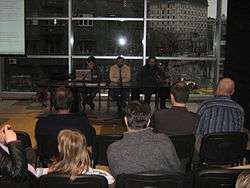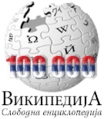Serbian Wikipedia
 | |
|
| |
Type of site | Internet encyclopedia project |
|---|---|
| Available in | Serbian |
| Headquarters | Miami, Florida |
| Owner | Wikimedia Foundation |
| Website | sr.wikipedia.org |
| Commercial | No |
| Registration | Optional |
The Serbian Wikipedia (Serbian: Википедија на српском језику/Vikipedija na srpskom jeziku) is the Serbian-language version of the free online encyclopedia Wikipedia. Created on 16 February 2003, it reached its 100,000th article on 20 November 2009 before getting to another notable milestone with the 200,000th article on 6 July 2013.
It currently has 129,022 registered users (637 active ones) and about 343,000 articles, making it the second largest South Slavic Wikipedia (28th overall), just behind Serbo-Croatian Wikipedia (19th overall).[1]
The Serbian Wikipedia uses ZhengZhu's character mapping program to convert between Cyrillic and Latin scripts.
History
Serbian Wikipedia was created on 16 February 2003 along with the Croatian Wikipedia when both split off from the joint Serbo-Croatian Wikipedia. The main page was translated from English into Serbian on 22 April 2003 by an unknown user with IP address 80.131.158.32 (possibly from Freiburg, Germany), and user Nikola Smolenski finished the translation on 24 May.
During September 2003, Smolenski prepared the main page along with creating some basic article stubs. In the October 2003 issue of the Serbian IT magazine Svet kompjutera his article about wikis and Wikipedia got published,[2] leading to a surge of new users, both registered and anonymous. Around the same time, Smolenski also translated the user interface page into Serbian.
Variants
The Serbian language uses two alphabets, Cyrillic and Latin. It also has two official accents: Ekavian and Ijekavian. Combining the scripts and accents give four written variants (Ekavian Cyrillic, Ijekavian Cyrillic, Ekavian Latin, and Ijekavian Latin).

When the Serbian Wikipedia was founded, it used only the Cyrillic alphabet, and both standard dialects. However, since both alphabets are widely used by Serbian native speakers, an effort began to enable the parallel usage of both Cyrillic and Latin alphabets. The first attempt was to use a bot for dynamic transliteration of every article. About 1,000 articles were transliterated before the action was stopped due to technical difficulties. This concept was later abandoned in favor of a model used by the Chinese Wikipedia. After a few months, the software was completed and now every visitor has the option to choose between two alphabets using tabs at the top of each article. There are special tags used to indicate those words which should not be transliterated (for example, names and words written in foreign languages). Anti-transliteration tags in use are:
-
-{text here}-, that prevents transliteration of the article text, and -
or__БЕЗКН__, that prevents transliteration of the article's name.
Though there are still minor technical issues, Cyrillic-Latin transliteration is working successfully.
Ekavian–Ijekavian conversion, however, is much more complicated, and its implementation is not yet complete (it will probably require extensive tables of words in Ekavian and Ijekavian forms). However, despite the difficulties, this is probably the first successful attempt to develop the software which will allow parallel work on all four variants of the Serbian language.
Community

Ever since the inaugural meeting on Tuesday, 15 February 2005, members of the Serbian wiki community have been holding regular gatherings. As of September 2013, 253 meetings took place — mostly in Belgrade, with about a dozen taking place in Novi Sad, along with a few in Niš, Pančevo, and Pirot.
At first congregating at each other's apartments, bars, restaurants, and public parks, by late 2005 community members began gathering at the Belgrade Youth Center, which provided meeting space free of charge. At the very first of these Youth Center meetings on Saturday, 3 December 2005, the community members founded the Wikimedia Foundation's local chapter for Serbia and Montenegro called Wikimedia Serbia and Montenegro (Викимедија Србије и Црне Горе). At the time, it was only the fifth local Wikimedia Foundation chapter anywhere in the world.
Following the May 2006 Montenegrin referendum whose outcome led to the breakup of the Serbia and Montenegro state union, the local chapter modified its name to Wikimedia Serbia (Викимедија Србије). It is registered as a non-governmental, non-partisan, and non-profit organization and its stated goals include promotion of the creation, gathering and multiplication of free content in Serbian language as well as promotion of the idea that everyone should have equal access to knowledge and education. Later that year in December, the Serbian chapter hosted the very first Wikimedia regional conference for Southeast Europe.
Three more regional conferences were put together over the next several years, all of them hosted by Wikimedia Serbia.
In February 2012, Wikimedia Serbia organized an event called Open Wiki GLAM of Serbia as part of the bigger project of the same name. Standing for Galleries, Libraries, Archives & Museums, GLAM is devoted to the topics of Serbian cultural and historical heritage as well as protection of intellectual property and copyright on the Internet. Later that year in December, Wikimedia Serbia got its own office space located in downtown Belgrade at the beginning of the King Aleksandar Boulevard where most of the Serbian wiki community meetings now began to take place.
Content
Serbian Wikipedia cooperates with the University of Belgrade's Faculty of Mathematics, Faculty of Physical Chemistry and Faculty of Philology as well as the University of Montenegro's Faculty of Electrical Engineering. Students of those faculties have made occasional contributions to the Serbian Wikipedia by editing its articles.
Due to the similarity of the varieties of Serbo-Croatian, one of the features is copying and adapting articles from one language version of Wikipedia to another (Serbian, Croatian, Serbo-Croatian and Bosnian.) Another Serbian language project, Serbian Wikinews (as of October 2010) has more than 52,000 articles, so the Wikipedia articles are often accompanied by latest news.
A controversy erupted in 2006 over some 10,000 articles on French communities created by a bot. The problem was that such articles needed transcription, and that process went slowly.
Some 1500 human-written articles, including articles on a number of topics related to social work that even the English Wikipedia doesn't have, were bot-uploaded to the Serbian Wikipedia from the Dictionary of Social Work, after author Ivan Vidanović offered to release them under the GFDL.
During September and October 2007, new articles on more than 4,300 towns in Serbia and 1,250 in Montenegro were created. Already existing articles (about 1,600 towns from Serbia and 80 towns from Montenegro) were manually merged with bot-created articles.
From July 13 to July 17, 2009, about 2,400 articles on artificial satellites from the Soviet-Russian Cosmos program were created, and in August 2009 an additional 7,840 articles about deep sky objects from the New General Catalogue were added.
Gallery
 The Serbian Wikipedia's 100K commemorative logo. (11 October 2009)
The Serbian Wikipedia's 100K commemorative logo. (11 October 2009) The Serbian Wikipedia's 150K commemorative logo. (20 November 2011)
The Serbian Wikipedia's 150K commemorative logo. (20 November 2011) Web Fest 2009 award in the 'best educational site in Serbia' category for sr.wikipedia.org
Web Fest 2009 award in the 'best educational site in Serbia' category for sr.wikipedia.org
References
- Lih, Andrew. The Wikipedia Revolution: How a Bunch of Nobodies Created the World's Greatest Encyclopedia. Hyperion, New York City. 2009. First Edition. ISBN 978-1-4013-0371-6 (alkaline paper).
Notes
External links
| Serbian edition of Wikipedia, the free encyclopedia |
- (Serbian) Serbian Wikipedia
- (Serbian) Serbian Wikipedia mobile version (not fully supported)
| Wikimedia Commons has media related to Serbian Wikipedia. |
